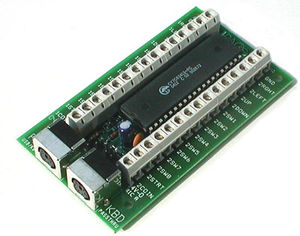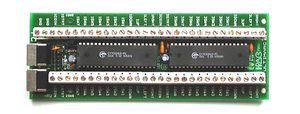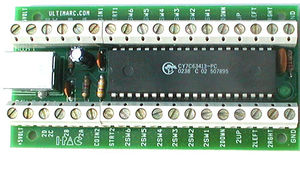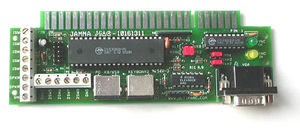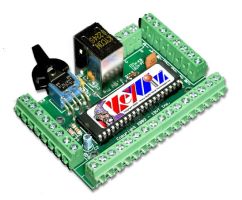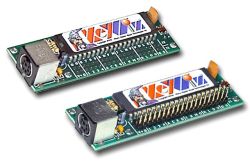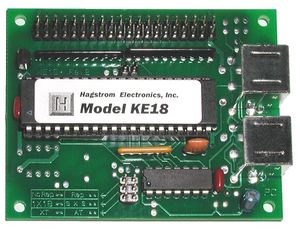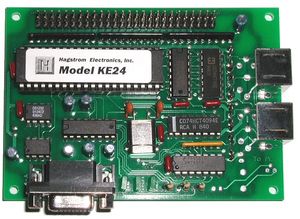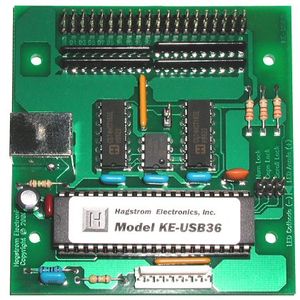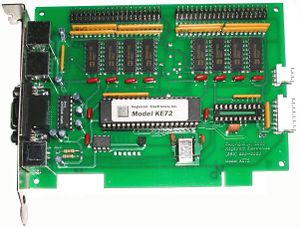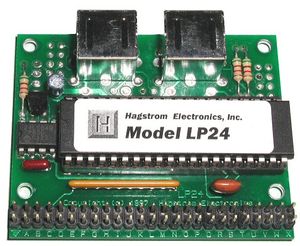Difference between revisions of "Keyboard Encoders"
(→I-PAC4) |
(→I-PAC VE) |
||
| Line 26: | Line 26: | ||
==I-PAC VE== | ==I-PAC VE== | ||
| − | [[image:ipac_ve.jpg|right|thumb|I-PAC VE]] | + | [[image:ipac_ve.jpg|right|thumb|I-PAC VE Photo © Ultimarc.com, Used with permission.]] |
This "value edition" of the I-PAC only comes in USB form. It is suitable for all Windows versions, Linux, and Mac, but not DOS. You may require a standard A-B USB cable (check the Ultimarc website for details regarding this). | This "value edition" of the I-PAC only comes in USB form. It is suitable for all Windows versions, Linux, and Mac, but not DOS. You may require a standard A-B USB cable (check the Ultimarc website for details regarding this). | ||
| Line 34: | Line 34: | ||
'''Relevant Link: [http://www.ultimarc.com/ipacve.html Ultimarc's I-PAC VE Page]''' | '''Relevant Link: [http://www.ultimarc.com/ipacve.html Ultimarc's I-PAC VE Page]''' | ||
| − | |||
==J-PAC== | ==J-PAC== | ||
Revision as of 19:17, 11 March 2014
Keyboard Encoders offer the functionality of a keyboard hack in an easy-to-use form. They offer several benefits including reduction of ghosting, ease in connecting controls and time savings.
Contents
I-PAC2
Ultimarc's IPac2 was the first full-featured affordable keyboard encoder to hit the BYOAC community and quickly became the hook-up of choice. Up until it's release most people were still hacking keyboards, since most keyboard encoders came with a high price tag or were difficult to find.
It's still a very popular choice and comes in PS/2 and USB flavours.
Both versions have 28 inputs. They are all programmable and are designated as 2 joysticks, 8 buttons each, plus coin1, coin2, start1, start2. One of the inputs is assigned as a shift key to access an alternate code set (usefull if you want to keep administrative buttons to a minimum on your control panel). Both models also have connectors for NumLock, CapsLock and ScrollLock keyboard LEDs.The PS/2 model includes a very usefull keyboard passthrough.
Relevant Link: Ultimarc's I-PAC2 Page
I-PAC2 FS32
Ultimarc's IPac2 FS32 is a new model of the IPac2. I has the same features as the IPac2 but with more inputs (32 vs. 28)
Relevant Link: Ultimarc's I-PAC2 Page
I-PAC4
The I-PAC4 is designed for 4-player panels or where large numbers of inputs are needed. It also comes in PS/2 and USB versions.
Both versions have 56 inputs and are all programmable and designated 4 joysticks, 8 buttons each plus coin 1,2,3,4 and start 1,2,3,4. Two of the inputs are assigned as shift keys to access two separate codes sets covering the player 1,2 and the player 3,4 inputs, usefull if you want to keep administrative buttons to a minimum on your control panel
Relevant Link: Ultimarc's I-PAC4 Page
I-PAC VE
This "value edition" of the I-PAC only comes in USB form. It is suitable for all Windows versions, Linux, and Mac, but not DOS. You may require a standard A-B USB cable (check the Ultimarc website for details regarding this).
One important difference with this model is that when a custom codeset is used, it is stored in RAM instead of EEPROM, meaning that storage needs refreshing after power-down (this does not apply if you always use the built-in default MAME code set of course, the settings revert to MAME on power-down)
This model has 32 inputs. They are all programmable and are designated as 2 joysticks, 8 buttons each, plus coin1, coin2, start1, start2. One of the inputs is assigned as a shift key to access an alternate code set (usefull if you want to keep administrative buttons to a minimum on your control panel). This model also has connectors for NumLock, CapsLock and ScrollLock keyboard LEDs.
Relevant Link: Ultimarc's I-PAC VE Page
J-PAC
The J-PAC is an encoder which allows plug-in connection of a JAMMA arcade cabinet to a VGA card and keyboard port or USB port on a PC motherboard, and incorporates all the functions of the standard I-PAC's and has a dual interface for PS/2 and USB.
Relevant Link: Ultimarc's J-PAC Page
KeyWiz MAX
A high-performance keyboard encoder produced by Groovy Game Gear. It features screw terminal headers on the PCB for easy hookup and a switch to allow the "pass-thru" use of a connected keyboard.
The KeyWiz line of keyboard encoders feature 32 inputs and connect to a PC via the keyboard PS2 port. The Keywiz has the default MAME codeset hard-coded by default. Custom codesets can easily be created and loaded into RAM on the Keywiz via its included software. This software can be placed in the Windows Startup folder to automatically load a custom keyset each time the computer is booted.
The Keywiz uses a SHAZAAM key to allow most of the inputs to have alternate keycodes. For example, pushing the SHAZAAM key and the Player 1 button #2 is the same as hitting the TAB key. This function allows many "administrative" keys to be accessed without dedicated pushbuttons to clutter the control panel.
Relevant Link:
GroovyGameGear's KeyWiz MAX Page
KeyWiz Eco 2
A high-performance keyboard encoder produced by Groovy Game Gear. This encoder boasts the same performance as the KeyWiz Max, but without keyboard pass-thru or screw terminal headers on the PCB. The KeyWiz Eco is available in a "solder" and "no solder" version.
The KeyWiz line of keyboard encoders feature 32 inputs and connect to a PC via the keyboard PS2 port. The Keywiz has the default MAME codeset hard-coded by default. Custom codesets can easily be created and loaded into RAM on the Keywiz via its included software. This software can be placed in the Windows Startup folder to automatically load a custom keyset each time the computer is booted.
The Keywiz uses a SHAZAAM key to allow most of the inputs to have alternate keycodes. For example, pushing the SHAZAAM key and the Player 1 button #2 is the same as hitting the TAB key. This function allows many "administrative" keys to be accessed without dedicated pushbuttons to clutter the control panel.
Relevant Link:
GroovyGameGear's KeyWiz Eco 2 Page
KE18
The KE18 is sold with MiniDIN 6-pin (PS/2) connectors however the manual mentions the board is sold with 5-pin DIN (AT-Style) connectors.
The control board is fairly basic, including no shift keys and a fixed key table (however alternate key codes and a different scanning arrangement can be specified upon ordering). The KE18's most notable feature is compatibility with older PC interfaces, a feature that might be desirable when maintaining older computer hardware. Another desirable feature for some is a keyboard pass-through port which allows a keyboard to remain connected to the PC.
Three jumpers allow some configuration options:
No Rep|Rep: Disables or Enables the repeat function of the keyboard interface.
1x18|9x9: Changes from a 18 key direct input to a 9x9 (for a total of 81 inputs) matrix mode.
XT|AT: Alternates between XT or AT PC mode.
Note: It is unclear from the documentation whether ghosting in matrix mode is addressed.
Relevant Link: Hagstrom's KE18 Page
KE24
The KE24 is a PS/2 (MiniDIN) or AT (DIN) programmable interface board with a keyboard pass-through port. The KE24 manual makes no mention of native USB support.
Each of the 24 inputs can be individually programmed in matrix or direct input mode. eg, 7 pins can be programmed as a 4x3 matrix (such as a standard 0-9,#,* keypad) while the remaining 17 inputs can be programmed as direct input. Thus the inputs can be programmed as 24 individual inputs, a matrix of 12x12 allowing for 144 inputs or any combination in between. In addition, any input can be assigned a macro consisting of up to 16 keystrokes.
An RS-232 I/O port is included and is used as a programming port to configure the board, allow simulated key strokes to be feed to the control board and to obtain key strokes from the control board. Programming is done with an included software (Unspecified OS) application.
Relevant Link: Hagstrom's KE24 Page
KE-USB36
The KE-USB36 emulates a standard USB Keyboard and Mouse device. Any keystroke may also be modified with a Ctrl, Alt, or Shift function, or any combination of the three modifiers. In addition to keystrokes, inputs may be programmed to emulate mouse Left, Middle, and Right buttons.
The KE-USB36 features a Trackball input for conversion of this device to mouse movement. (A Spinner may be used instead of a Trackball)
The KE-USB36 is programmed through the USB port of the PC using the programming application included with the unit. Once programmed, the configuration is stored on the KE-USB36 in non-volatile memory.
All power for the KE-USB36 is taken from the PC USB port, so no other voltage supply is required.
Relevant Link: Hagstrom's KE-USB36 Page
KE72
The KE72 features 72 individual inputs. Each input may be programmed to output a single keystroke, or a sequence (macro) of keystrokes. For macros, each input may generate up to 32 keystrokes when activated, and up to 16 keystrokes when the input is released. The KE72 is able to emulate any keystroke found on a standard 101 or 104 key keyboard.
Relevant Link: Hagstrom's KE72 Page
LP24
PS/2 or USB or both?
Number of Inputs
Designated for anything?
Shift keys?
Additional features?
Relevant Link: Hagstrom's LP24 Page
Mini-PAC
A very versatile keyboard/trackball/spinner encoder. The Mini-PAC interfaces either over USB or over PS2 (PS2 only works for buttons). The interface does not suffer from ghosting and matrix side-effects common to regular USB keyboards. The board is actually a small-size I-PAC2 with 3 optical interfaces added.
It interfaces 28 buttons and 3 analogue inputs for a trackball and a spinner.
It has default MAME style input mapping and a second programmable mapping. Utilities for programming under DOS, Windows, OSX and Linux are delivered with the Mini-PAC
It has a shift function for adding secondary functions to connected buttons.
An optional harness is available to easy connect the Mini-PAC to 28 buttons/joyctick switches and to 3 analogue controls.
Relevant Link: Ultimarc's Mini-PAC Page
X-Arcade BYO Kit
X-Arcade™ Build Your Own Arcade Features
PC Arcade Controller 2 Player Version(With USB/PS2 ADAPTER) For MAME Cabinet
Supports 2 x Joysticks,12 x fire buttons(each 6 buttons for 2 player),P1 Start,P2 Start,Insert Coin. Extra inputs for Pause[P],MAME Menu[Tab],Quit Game[Esc]. Connects to the PS2 port of your PC with a supplied 1.5m cable. Simple plug & play.No drivers or software required. Easily mountable compact control box Long 55 cm harness insulated steel cable.All cables are paired together and labelled for easy connection.
6.3mm female crimp terminals for connection to standard micro-switches. Supports all Happ/Suzo type joysticks and buttons. No programming and no key-mapping software needed. No key ghosting or blocking. Compatible with all versions of M$ Windows and M$-DOS. It is simply the easiest way to interface a PC with arcade controls. The ideal solution if you want to run MAME in an arcade cabinet. Includes an easy to follow installation manual.
Relevant Link: Y-Plus ADAPTER
